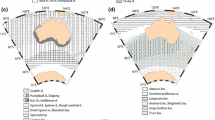Abstract
When humans take to the water, they generate sound. This is helpful for the detection, classification, localisation and tracking of certain activities for purposes of border security, health and safety of offshore industrial development, environmental management, etc. The most commonly measured acoustic quantity is pressure. Vector quantities related to particle motion, such as particle velocity and acceleration, can equally identify the activity and they carry directional information. Acoustic pressure and particle motion were measured from 10 water sports activities within an Olympic-sized pool: swimming backstroke, breaststroke, butterfly and freestyle; snorkelling with fins; kicking a boogie board with fins; paddling with alternating or simultaneous arms while lying on a surfboard; scuba-diving; kayaking and jumping into the pool. Activities that occurred at the surface and that involved repeatedly piercing the surface were the strongest sound generators. Surface activities that produced fewer bubbles and scuba-diving at depth generated less broadband power. The vector fields around water sports activities can be expected somewhat different in the open ocean from within a pool, and more research is needed to understand how marine fauna might perceive these vector quantities.






Similar content being viewed by others
References
Wyatt, R.: Review of existing data on underwater sounds produced by the oil and gas industry. In: Joint Industry Programme on Sound and Marine Life, London (2008)
Illinworth and Rodkin Inc.: Compendium of Pile Driving Sound Data. Illinworth and Rodkin Inc., Petaluma (2007)
Carroll, A.G., Przeslawski, R., Duncan, A., Gunning, M., Bruce, B.: A critical review of the potential impacts of marine seismic surveys on fish and invertebrates. Mar. Pollute Bull. 114(1), 9–24 (2017). doi:10.1016/j.marpolbul.2016.11.038
Richardson, W.J., Greene, C.R., Malme, C.I., Thomson, D.H.: Marine Mammals and Noise. Academic Press, San Diego (1995)
Reine, K.J., Clarke, D.G., Dickerson, C.: Characterization of underwater sounds produced by hydraulic and mechanical dredging operations. J. Acoust. Soc. Am. 135(6), 3280–3294 (2014). doi:10.1121/1.4875712
Erbe, C., Parsons, M., Duncan, A.J., Allen, K.: Underwater acoustic signatures of recreational swimmers, divers, surfers and kayakers. Acoust. Aust. 44(2), 333–341 (2016). doi:10.1007/s40857-016-0062-7
Mooney, T.A., Kaplan, M.B., Lammers, M.O.: Singing whales generate high levels of particle motion: implications for acoustic communication and hearing? Biol. Lett. 12, 20160381 (2016). doi:10.1098/rsbl.2016.0381
Kalmijn, A.J.: Hydrodynamic and acoustic field detection. In: Atema, J., Fay, R.R., Popper, A.N., Tavolga, W.N. (eds.) Sensory Biology of Aquatic Animals, pp. 83–130. Springer, New York (1988)
Wahlberg, M., Schack, H.B., Wilson, M., Bejder, L., Madsen, P.T.: Particle acceleration noise generated by boats. Bioacoustics 17(1–3), 148–150 (2008). doi:10.1080/09524622.2008.9753797
Casper, B.M., Mann, D.A.: Evoked potential audiograms of the nurse shark (Ginglymostoma cirratum) and the yellow stingray (Urobatis jamaicensis). Environ. Biol. Fishes 76(1), 101–108 (2006). doi:10.1007/s10641-006-9012-9
Casper, B.M., Mann, D.A.: Dipole hearing measurements in elasmobranch fishes. J. Exp. Biol. 210(1), 75–81 (2007). doi:10.1242/jeb.02617
Horodysky, A.Z., Brill, R.W., Fine, M.L., Musick, J.A., Latour, R.J.: Acoustic pressure and particle motion thresholds in six sciaenid fishes. J. Exp. Biol. 211, 1504–1511 (2008). doi:10.1242/jeb.016196
Wysocki, L.E., Codarin, A., Ladich, F., Picciulin, M.: Sound pressure and particle acceleration audiograms in three marine fish species from the Adriatic Sea. J. Acoust. Soc. Am. 126(4), 2100–2107 (2009). doi:10.1121/1.3203562
Acknowledgements
The authors thank Leila Fouda, Sven Gastauer, Sylvia Osterrieder, Nicholas Riddoch and Rebecca Wellard, all of the Centre for Marine Science and Technology at the time, for swimming in a cold public pool during the off-season. David Minchin and Malcolm Perry kindly assisted with equipment preparation, calibration and data collection. The authors are also grateful to Scotch College and the University of Western Australia for the use of their pools during tests.
Funding This study was funded by the Western Australian Government, Office of Science, under the Applied Research Program—Round 2. The Western Australian Government does not endorse any information, product, process or outcome, arising from or in relation to this study.
Author information
Authors and Affiliations
Corresponding author
Ethics declarations
Conflict of interest
The authors declare that they have no conflict of interest.
Rights and permissions
About this article
Cite this article
Erbe, C., Parsons, M., Duncan, A.J. et al. Underwater particle motion (acceleration, velocity and displacement) from recreational swimmers, divers, surfers and kayakers. Acoust Aust 45, 293–299 (2017). https://doi.org/10.1007/s40857-017-0107-6
Received:
Accepted:
Published:
Issue Date:
DOI: https://doi.org/10.1007/s40857-017-0107-6




